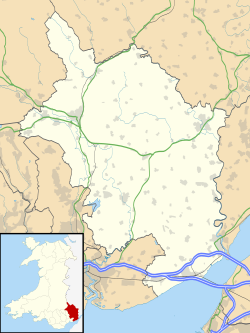| St Peter's Church, Bryngwyn, Monmouthshire | |
|---|---|
| Church of St Peter | |
 The entrance and tower | |
| 51°46′45″N2°53′05″W / 51.7792°N 2.8848°W | |
| Location | Bryngwyn, Monmouthshire |
| Country | Wales |
| Denomination | Church in Wales |
| History | |
| Status | parish church |
| Founded | C13th century |
| Architecture | |
| Functional status | Active |
| Heritage designation | Grade II* |
| Designated | 9 January 1956 |
| Architectural type | Church |
| Administration | |
| Diocese | Monmouth |
| Archdeaconry | Monmouth |
| Deanery | Raglan/Usk |
| Parish | Bryngwyn |
| Clergy | |
| Rector | Rev'd Canon Sally Ingle-Gillis |
The Church of St Peter, Bryngwyn, Monmouthshire, Wales is a parish church with its origins in the 13th century. It is a Grade II* listed building.
